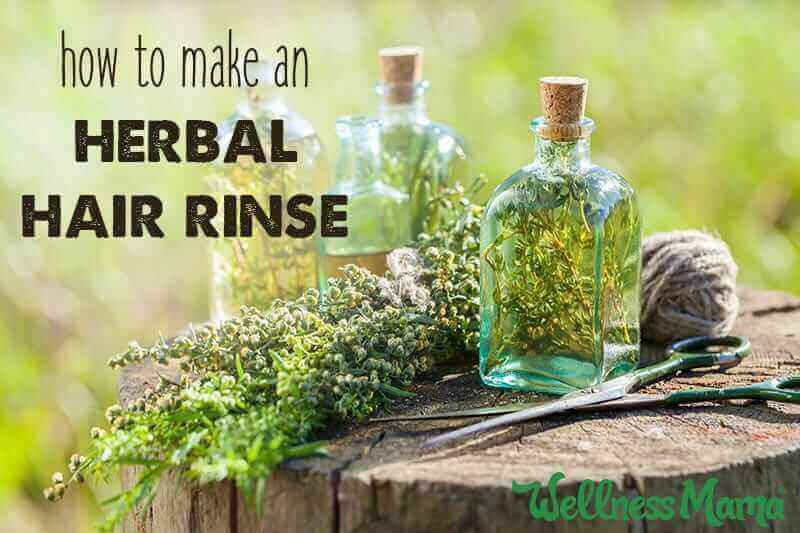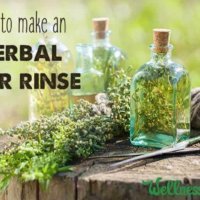Plenty of hair care commercials promise shiny, beautiful hair, but at what cost? This DIY herbal hair rinse recipe nourishes the scalp, boosts shine, and strengthens hair naturally without the downsides of chemicals and parabens.
The problem with many hair care items, even many of the natural ones, is that they strip the natural oils from the hair. Many shampoos also contain ingredients that coat the hair for that smooth, silky feel, to replace the oils it’s just stripped. It’s a frustrating cycle… but there are other ways!
This herbal hair rinse features nutritive herbs that feed the scalp for healthier, stronger hair. The apple cider vinegar softens and cleanses, without removing the scalp’s natural oils. This rinse easily fits into a no-poo lifestyle but can also be used with shampoo. With regular use, hair may even go longer between washes (always a plus!).
Herbal Hair Rinse: The Herbs
This rinse is infused with beneficial herbs that help hair in a variety of ways:
Horsetail (Yes, Horsetail!)
This favorite herb of mine contains high amounts of silica to strengthen hair strands (which is why I also use it in my hair mask recipe!). Many shampoos contain silicon to coat the hair but this only copies the effect. Horsetail is also rich in calcium, magnesium, bioflavonoids, chromium, potassium, copper, and iron to name a few.
Horsetail is also slightly astringent, which is helpful for oily hair.
Lavender and Rosemary
Lavender calms inflammation on the scalp and increases circulation for better growth. Rosemary herb also affects circulation and stimulates growth. Like horsetail, rosemary is also slightly astringent, which works to strengthen the hair follicles and prevent hair loss.
Nettle
Nettle is really a wonder herb as it’s full of vitamins and minerals. You’ll find vitamin A carotenoids, vitamins B, C, D, and K, as well as calcium, magnesium, boron, chromium, silica, and others. By nourishing and increasing the health of the scalp, nettle makes hair naturally stronger and more vibrant.
Basil
Basil is the last herb used in this mix and it plays a special role. Like the other herbs, basil feeds the scalp, but it also helps the body to remove toxins and heavy metals. Basil promotes hair growth as it nourishes with vitamins A and C, flavonoids, and polyphenolic acids.
Herbal Hair Rinse Recipe
Materials
- ¼ cup nettle leaf
- ¼ cup horsetail
- 3 TBSP dried basil
- 4 TBSP dried lavender
- 3 TBSP dried rosemary
- 3 to 3 ½ cups apple cider vinegar
Instructions
- Add all of the dried herbs to a quart-size glass jar.
- Cap the jar and shake to mix, or stir with a spoon.
- Fill the jar to 1 inch from the top with apple cider vinegar.
- Cap it tightly, and shake vigorously.
- Keep the jar in a cool, dark location for 2-4 weeks, shaking it every day or so.
- After the first few days you may notice that the herbs have absorbed some of the vinegar. Just top your jar off with some more vinegar so that it stays about 1 inch from the top.
- After 2-4 weeks, then strain the herbs out with a cheesecloth or a very clean old t-shirt fabric. You can also strain it with a fine mesh sieve, then line your sieve with a coffee filter and run it through again.
- Store your herbal hair rinse in a clean glass jar.
To Use:
- After cleaning hair as usual, mix equal parts of the prepared herbal hair rinse and water together in an empty mason jar or other container. Use ¼ cup of each for short hair, ½ cup of each for shoulder-length hair, and ? cup of each for long hair.
- Tip your head back and slowly pour the herbal rinse through your hair.
- Tilt your head from side to side and work your fingers through it as you pour to help it reach all areas.
- You can leave the herb rinse in, or wash it out briefly with water.
Notes
Store your herbal hair rinse in a clean glass jar. When you go to use it, dilute it with 1 part of filtered water. The vinegar concentrate will keep indefinitely; however water will encourage mold and bacterial growth, so don’t store the rinse pre-diluted with water.
How to Use Your Herbal Hair Rinse
After cleaning hair as usual, mix equal parts of the prepared herbal hair rinse and water together in an empty mason jar or other container. The following guidelines should give you a good idea of how much herbal hair rinse to use each time. You may need less or more rinse depending on the length and thickness of your hair.
- Short hair: ¼ cup infused vinegar to ¼ cup water
- Shoulder-length hair: ½ cup infused vinegar to ½ cup water
- Long hair: 2/3 cup infused vinegar to 2/3 cup water
Tip your head back and slowly pour the herbal rinse through your hair. Tilt your head from side to side and work your fingers through it as you pour to help it reach all areas.
You can leave the herb rinse in, or wash it out briefly with water.
Additional Tips
- Use the herbal rinse once a week or even every day according to preference.
- Use this hair rinse in between shampoo sessions, or even in place of them if you find that works for you.
Have you ever used an herbal rinse? Did you notice a difference in your hair? Let me know in the comments!




Leave a Reply